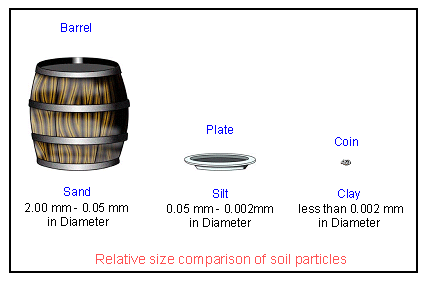Lesson Outline
Lesson Media Objects
 Deana Namuth-Covert
Deana Namuth-Covert
Professor, Director of Online Education and Outreach, The Ohio State University; Agronomy & Horticulture Adjunct Professor, University of Nebraska
dcovert2@unl.edu
Erosion
Factors Continued...Soil Properties
Soil Properties  
Soil texture (proportion of clay, silt, and sand particles in a soil) has two effects on soil erosion. The first is in its influence on infiltration or entry of water into the soil. When rainfall infiltrates rapidly, runoff is minimal. For example sandy textured soils have large pores acting like large pipes that allow much of the rainfall to soak right into the soil. Sandy soils are known to have good infiltration and drainage. Clay textured soil have small pores more like narrow pipes that do not allow water to soak into the soil fast. Clay soils are known to have poor infiltration and drainage.
Second, particles vary in their ease of detachment. Silt particles are most easily detached because they are small and do not easily form aggregates.
 |
|
Image by NASA Globe program http://ltpwww.gsfc.nasa.gov/globe/pvg/texture1.htm |
Aggregation
Particles of fine sand, silt and clay may join together to form aggregates. The soil property which describes the character and formation of these aggregates is called soil structure. The glue that joins the soil particles together includes organic matter, clays, iron oxides, aluminum oxides, and lime. Aggregate formation in clay-textured soil improves water infiltration into the soil and drainage because it increases the number of large pores (larger pipes). In sandy textured soil, aggregate formation reduces the excessively fast drainage of water by increasing the number of small pores (narrow pipes).
Aggregates can be described by their grade. The grade is a measure of how well the aggregate is cemented together or, conversely, how easily it is broken down by the impact of water, wind, or human activity. A soil with good structure has many aggregates present which are stable, meaning well cemented together. Such aggregates resist the forces of water, wind, and human activity. Consequently, they can maintain their porosity and allow better water and air movement.
Soil Moisture
Moist soils are less prone to wind erosion due to the cohesive or binding effects of water on soil clay and organic matter. As wind dries the soil, the risk of soil loss erosion by wind increases, especially if aggregate grades are weak. The risk peaks at or below permanent wilting point.
Thinking Questions:
What soil textural class is expected to have a low rate of water infiltration? Why?
What can be done to improve the water infiltration rates of soil?
|
Thinking Questions:
What change(s) in soil can cause soil to have low rate of water infiltration?
How might these changes come about?
|
|
|

 Deana Namuth-Covert
Deana Namuth-Covert
Comments